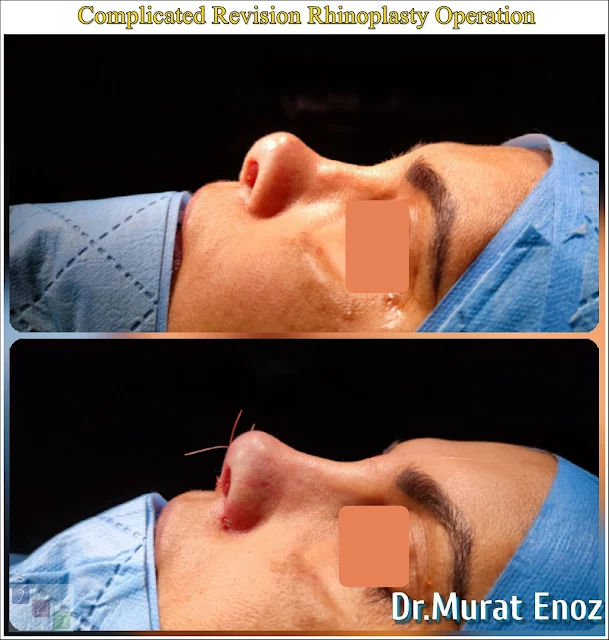Overreducted Nose Hump, Asymmetrical Nostrils, Asymmetrical Nose Bone, Hanging Columella ...
The problems written in the above title can sometimes occur even after rhinoplasty operations performed only once. The patient, who had a primary rhinoplasty operation 2 years ago in a different clinic, applied to our clinic because of aesthetic and functional problems in the nose. On examination of the patient, the following were found:
- drooping columella
- asymmetrical nostrils
- incision scars
- asymmetrical and flattened nasal bone
- features of thick and fibrotic skin
- asymmetrical nose wings
In fact, when you look at the images, you can see how asymmetrical the anatomical structure of the nose is. The patient underwent revision rhinoplasty using temporal muscle fascia, removal and rib cartilages. Although the operation performed here is a secondary nose job; It was more difficult than many 4th and 5th rhinoplasty operations I have done. Marginal rim grafts were placed on the left nasal wing of the patient. Left-sided alar base resection was performed. He placed temporal muscle fascia and cartilage grafts on the dorsum of the nose. Septoplasty was performed. Alar dome points have been changed. Columellar strut graft and cap graft were placed. Right external spreader graft was placed. These grafts were sutured with 6/0 pds. The operation was terminated after skin suturing. The patient was also recommended to use a long-term nostril retainer device. It was a complicated and difficult operation.
While it is easy to excise, reduce or resect a tissue in the nose; It is not easy to produce from the same tissue or to increase its volume in a similar way ... In the case I shared with you here, cartilage powder, cartilage, bone powder can be used for nasal augmentation for a patient whose arch and cartilage tissue on the dorsum of the nose has been excised excessively. The reason why we lay the temporalis fascia on the dorsum here is that it is a soft and natural camouflaging tissue, a tissue with high blood supply, and it is a very suitable material especially for patients with thin nasal skin and excessive roughness under the skin. Placing only block cartilage is not very suitable in these patients as it may cause asymmetric reflections. Although various industrial membrane-shaped structures are also used for this purpose; It is not suitable as it may increase the risk of infection and tissue reaction.
In some patients, more than one complicating factor, previous surgical trauma thick, skin features, altered anatomy and risk of circulatory problems may be present at the same time!
As in the patient I shared with you here, there may be more than one complicating factor that may cause the surgery to be much more difficult and complicated than other nose surgeries in patients for whom we are planning some revision rhinoplasty. In complicated nose surgeries that have been performed before, serious changes can occur in the anatomy of the nose, and as in the patient I shared here, it can be seen that there is a significant difference in symmetry in the nasal tip cartilages, supratip region and nasal bone on the right and left sides. At the same time, when we touch the skin of the patient's condition, it can be seen that the subcutaneous tissue is quite hard and different depressions and different protrusions can be noticed. The reason for this subcutaneous roughness here may be abnormal healing properties, fibrosis to suture reactions, or an asymmetric tissue removal. Again, in patients with thick skin who have had nose surgery before, recovery may take much longer after the operation. An unpredictable risk factor in revision rhinoplasty operations is the "risk of circulatory disorder". Sometimes, when we make subcutaneous incisions and dissect the skin during revision nose surgeries, we can see that the bleeding is not much and even the tissue can be cut without blood. This may make us think that the capillary circulation is quite disturbed and may cause us to get a little excited during the surgery. In some scientific studies, there are different recommendations, such as the evaluation of subnasal blood flow with Doppler ultrasonography before revision rhinoplasty, and in some studies, nasal massage before revision rhinoplasty, but it is inevitable that the blood supply in the nasal skin will decrease after repetitive rhinoplasty. In general, revision rhinoplasty operations, as I always say, are complicated procedures in which all details can be understood during the operation in the form of "opening a surprise box". It is very important that the surgeon performing the operation has good anatomical knowledge, good surgical experience and good evaluation of the patient. Patients who have undergone rhinoplasty many times before and who still have serious tissue changes in their nose may need to be rejected or not accepted, where the physician's main priority is to protect the patient.
Below you can see the patient's pre- and post-operative photos:
Murat Enoz, MD, Otorhinolaryngology, Head and Neck Surgeon
Private Office:
Address: İncirli Cad. No:41, Kat:4 (Dilek Patisserie Building), Postal code: 34147, Bakırköy - İstanbul
Appointment Phone: +90 212 561 00 52
Appointment Phone: +90 212 561 00 52
Fax: +90 212 542 74 47








Comments
Post a Comment